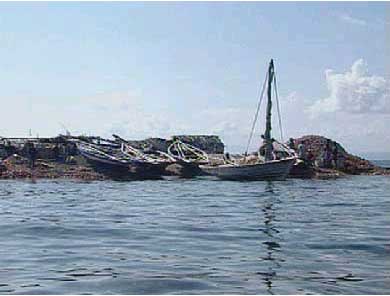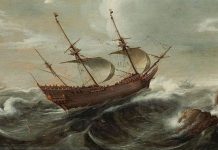
Ghost Ship – The Mary Celeste Story
The British brig Dei Gratia was about 400 miles east of the Azores on December 5, 1872, when crew members spotted a ship adrift in the choppy seas. Capt. David Morehouse was taken aback to discover that the unguided vessel was the Mary Celeste, which had left New York City eight days before him and should have already arrived in Genoa, Italy. He changed course to offer help.
Morehouse sent a boarding party to the ship. Belowdecks, the ship’s charts had been tossed about, and the crewmen’s belongings were still in their quarters. The ship’s only lifeboat was missing, and one of its two pumps had been disassembled. Three and a half feet of water was sloshing in the ship’s bottom, though the cargo of 1,701 barrels of industrial alcohol was largely intact. There was a six-month supply of food and water—but not a soul to consume it.
Thus was born one of the most durable mysteries in nautical history: What happened to the ten people who had sailed aboard the Mary Celeste? Through the decades, a lack of hard facts has only spurred speculation as to what might have taken place. Theories have ranged from mutiny to pirates to sea monsters to killer waterspouts. Arthur Conan Doyle’s 1884 short story based on the case posited a capture by a vengeful ex-slave, a 1935 movie featured Bela Lugosi as a homicidal sailor. Now, a new investigation, drawing on modern maritime technology and newly discovered documents, has pieced together the most likely scenario.
“I love the idea of mysteries, but you should always revisit these things using knowledge that has since come to light,” says Anne MacGregor, the documentarian who launched the investigation and wrote, directed and produced The True Story of the ‘Mary Celeste,’ partly with funding from Smithsonian Networks.
The ship began its fateful voyage on November 7, 1872, sailing with seven crewmen and Capt. Benjamin Spooner Briggs, his wife, Sarah, and the couple’s 2-year-old daughter, Sophia. The 282-ton brigantine battled heavy weather for two weeks to reach the Azores, where the ship log’s last entry was recorded at 5 a.m. on November 25.
After spotting the Mary Celeste ten days later, the Dei Gratia crewmen sailed the ship some 800 miles to Gibraltar, where a British vice admiralty court convened a salvage hearing, which was usually limited to determining whether the salvagers—in this case, the Dei Gratia crewmen—were entitled to payment from the ship’s insurers. But the attorney general in charge of the inquiry, Frederick Solly-Flood, suspected mischief and investigated accordingly. After more than three months, the court found no evidence of foul play. Eventually, the salvagers received a payment, but only one-sixth of the $46,000 for which the ship and its cargo had been insured, suggesting that the authorities were not entirely convinced of the Dei Gratia crew’s innocence.

![The-Mary-Celeste[1]](https://coolinterestingnews.com/wp-content/uploads/2012/07/the-mary-celeste1.jpg)












